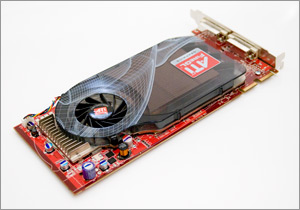Mid-Range Workstation GPU Shootout : FireGL V5600 vs. QuadroFX 1700 vs. FireGL V3600
ATI FireGL V5600 and V3600
The FireGL V5600 and V3600 share a common trait as they are based on the same GPU at their core, the only differences lie in the clock speeds, amount of memory on board, memory type, and cooling systems. Both the V5600 and V3600 are based on ATI’s RV630 graphics processor, which is also the heart of ATI’s Radeon 2600 XT and 2600 Pro graphics cards. If you compare the FireGL V5600 to the Radeon 2600XT and the FireGL V3600 to the Radeon 2600 Pro, you’ll notice that the cards are nearly identical in terms of design – the only visible differences lie in the logos which their cooling systems are adorned with.
ATI FireGL V5600 512 MB
|
I acATI FireGL V3600 256 MB
|
The RV630 graphics processor is quite flexible, as shown by the two cards we’re looking at today. Despite having the same GPU at their core, these cards can deliver very different performance levels and they sell for vastly different price points. The low-end V3600 has an MSRP of about $300, whereas the mid-range V5600 sells for twice that at $600. Why such a large price difference between two cards on the same GPU? We’ll tell you.
The V5600 runs its RV630 graphics processor at 800 MHz, whereas the V3600 runs it at 600 MHz. Right off the bat, this means that the V5600 is 33% more powerful in terms of raw GPU rendering performance. The V5600 also has twice the memory, a full 512 MB of GDDR-4 memory, whereas the V3600 only has 256MB of DDR2 memory. The V5600 also runs its memory modules much faster, at 1100 MHz which nets the card peak bandwidth levels of 35 GB/s. The V3600 runs it memory at less than half that, at 500 MHz for 16 GB/s of memory bandwidth. In order to deal with the additional heat created by the higher clocked GPU and memory chips, the V5600 comes with a much larger cooler and includes an elongated PCB.
The RV630 GPU has 120 stream processors, quite a bit less than the 320 stream processors used in the high-end R600 GPU we looked at earlier. It’s a unified shader design which is manufactured on an 80nm process. The GPU has an estimated 390 million transistors and measures 169mm squared, meaning it’s physically a larger chip compared to the one used in the QuadroFX 1700. The chip fully supports DirectX 10 and OpenGL 2.1, and sports ATI’s “Avivo HD” video processor. It’s definitely a solid mid-range GPU, when clocked high enough - and our tests with the FireGL V8560 showed us that ATI’s latest generation architecture does play well in the workstation market.
Both the FireGL V5600 and V3600 consume less than 75W of power, so both can be powered directly by a PCI Express x16 slot. This means that neither card requires a power adapter, which is somewhat rare in this day and age. Both cards also have two dual-link DVI ports, capable of driving 2560 x 1600 30” displays each. Neither card has HDTV or Stereo output ports, and neither can drive a Genlock/Framelock card. The V5600 card is equipped with a second-generation Crossfire multi-GPU connector, although ATI does not allow for multi-GPU performance bonding with their current FireGL driver set. Of course, multiple cards can be used in a single system, although they will run independently of each other.
V5600 Copper / Aluminum Cooling System
|
V3600 Copper Cooling System
|
Both cards fared quite well in terms of noise, as well. We found both the FireGL V5600 and V3600 to be very tolerable in terms of noise. Both cards feature thermal sensing fans, which ran at nearly in-audible noise levels throughout all of our testing.
ATI is definitely putting up a much more intense fight for the workstation market than they have before, as show by these two cards. The V5600 delivers a very solid feature set at an MSRP less than Nvidia’s competing QuadroFX 1700 card. The $299 V3600 card appears to be a good buy on paper as well, although we’ll need to see the performance numbers before judging it.










